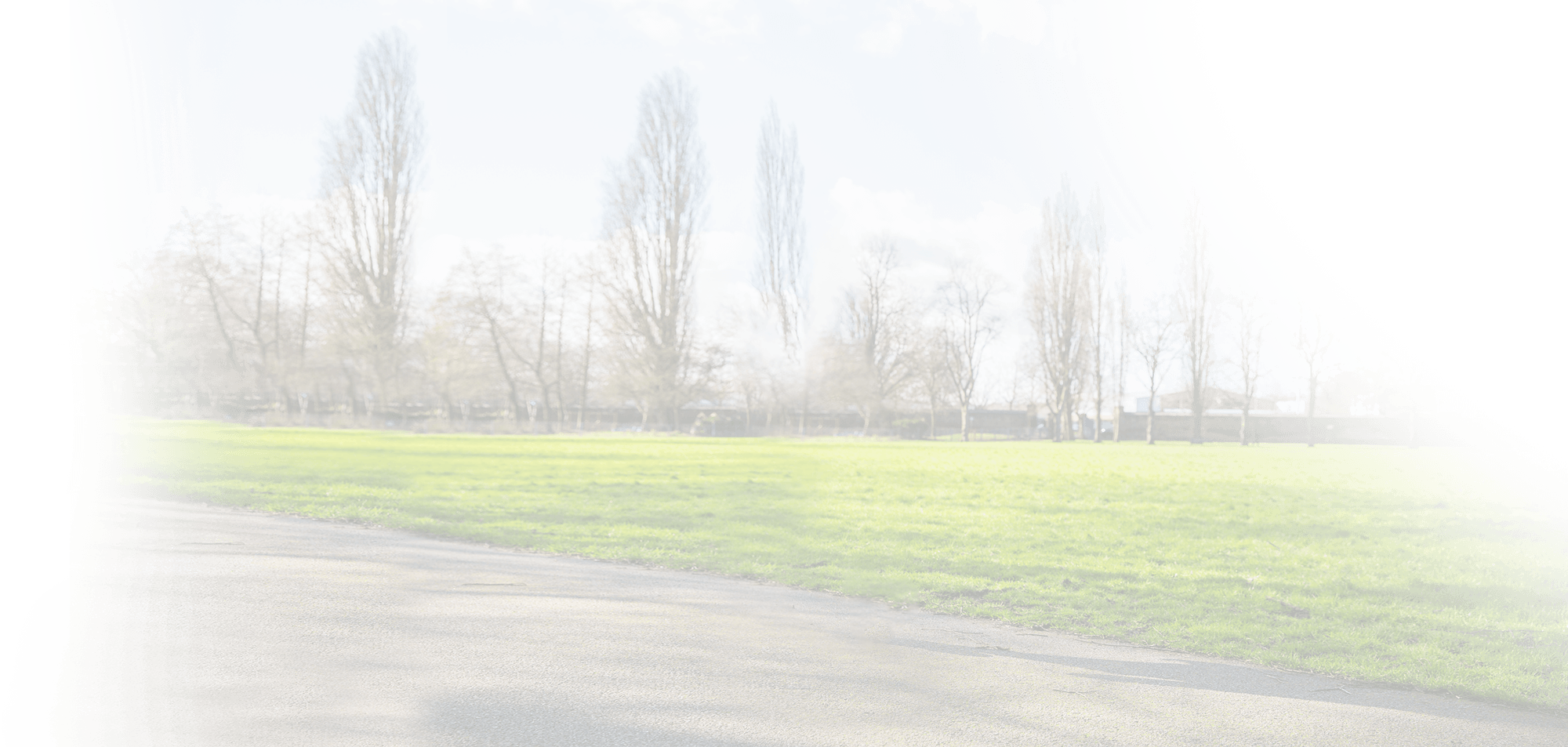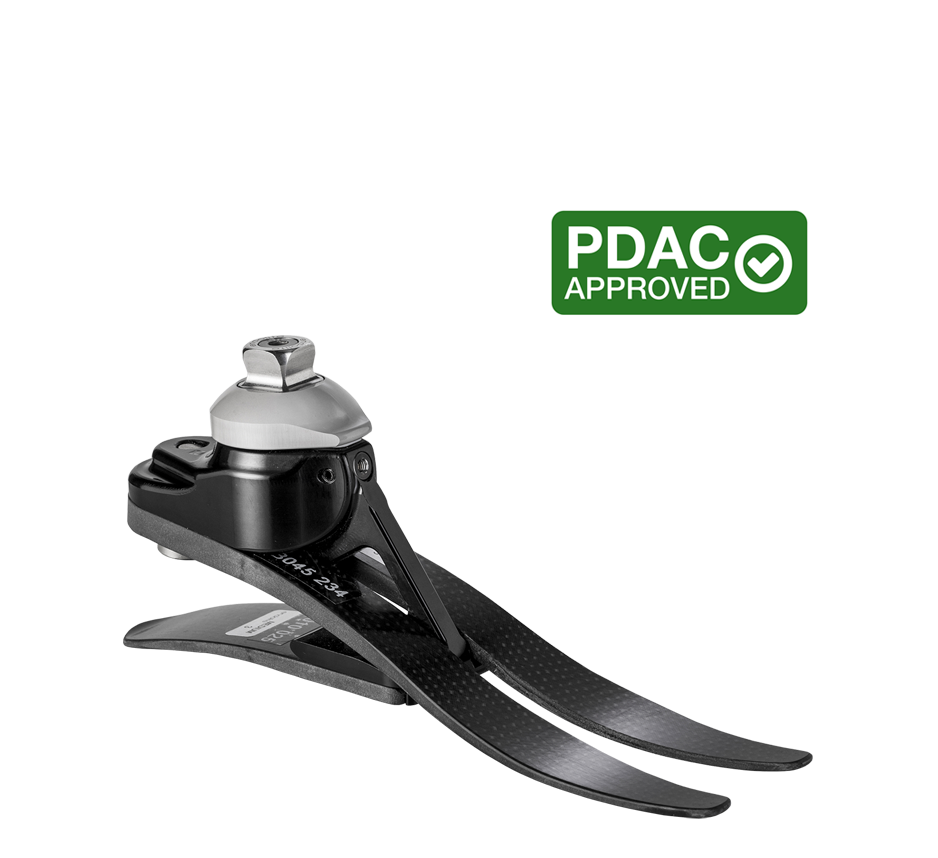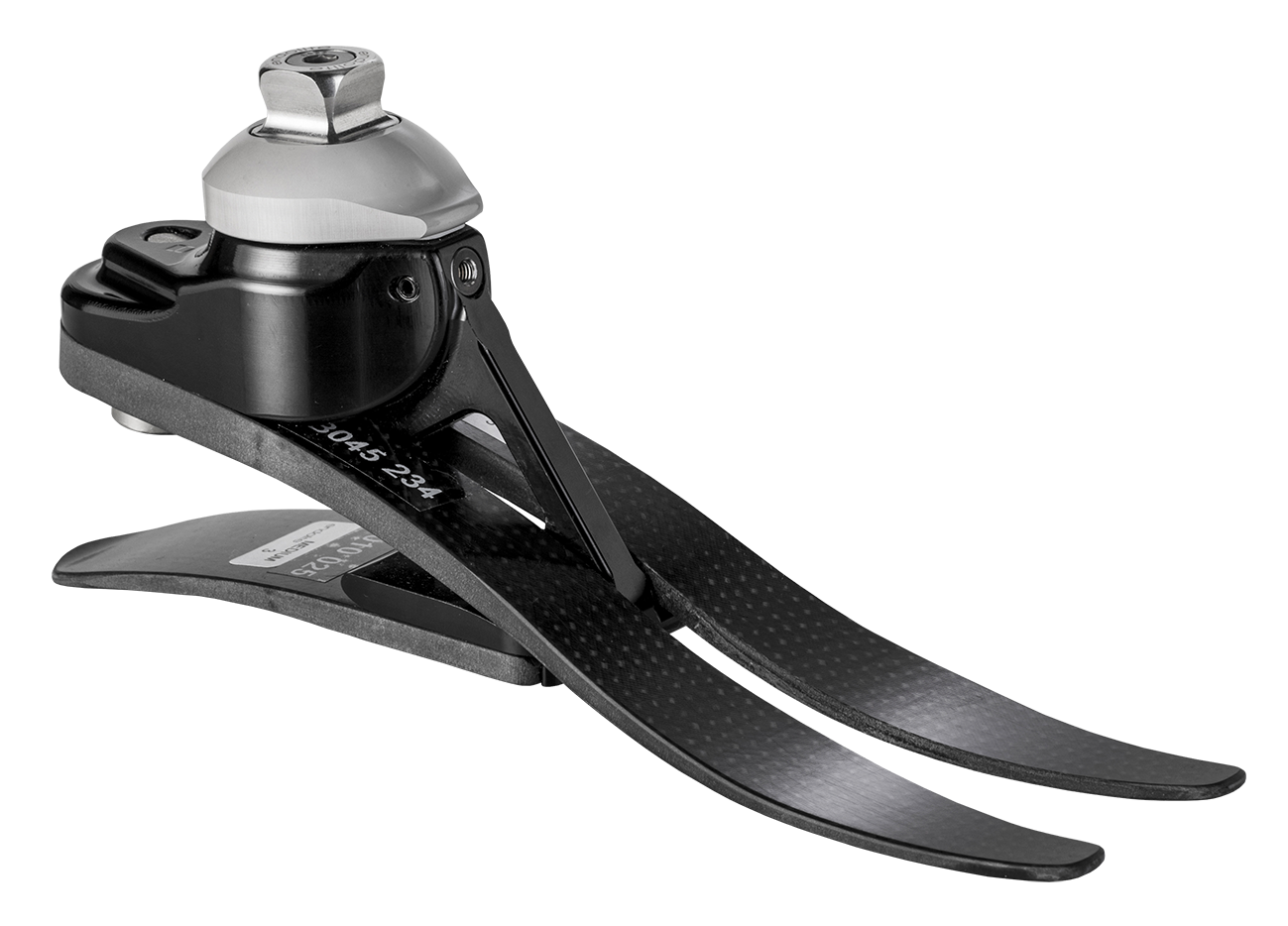Epirus
The Epirus foot is a low profile multi-axial prosthetic foot for Level 3 activity, combines a compliant biomimetic ankle joint with e-carbon springs to offer superb gait symmetry and an energy efficient response.
- Activity level 3
- Suitable for outdoor use
Epirus Clinical Evidence Reference
Clinical Outcomes using e-carbon feet
-
Safety
- High mean radius of curvature for Esprit-style e-carbon feet2: “The larger the radius of curvature, the more stable is the foot”
-
Mobility
- Allow variable running speeds3
- Increased self-selected walking speed4
- Elite-style e-carbon feet (L code VL5987) or VT units demonstrate the second highest mobility levels, behind only microprocessor feet5
-
Loading symmetry
- Users demonstrate confidence in prosthetic loading during high activity6
- Improved prosthetic push-off work compared to SACH feet7
- Increased prosthetic positive work done4
-
User satisfaction
- High degree of user satisfaction, particularly with high activity users8
Clinical Outcomes using Multiflex-style ankles
-
Safety
- Low stiffness at weight acceptance leads to early foot-flat and greater stability for lower mobility patients22
- No loss of stability during standing with Multiflex than fixed ankle/foot23
- Easier to walk on uneven ground with Multiflex than fixed ankle/foot23,24
- Easier to walk up a slope with Multiflex than fixed ankle/foot23
-
Mobility
- Little to no difference in gait mechanics compared to flexible, “energy storing” prosthetic feet25
- Increased prosthetic ankle range-of-motion with Multiflex compared to fixed ankle/foot23,24,26-28
- Increased prosthetic ankle power with Multiflex compared to fixed ankle/foot24
- Prosthetic rollover shape closer to natural biomechanics than fixed ankle/foot26
- Users can walk longer distances and report “smoother” gait with Multiflex compared to fixed ankle/foot24
- Benefits in mobility for bilateral users23,24,26,27
- Mixed objective results when user group was more active than is recommended for Multiflex29,30 so may benefit more from a similar but higher activity foot like Epirus.
-
Residual Limb Health
- Equivalent socket comfort to higher technology, energy-storing feet29
-
Loading Symmetry
- Improved stance phase timing symmetry with Multiflex compared to fixed ankle/foot28
- Reduced sound limb loading with Multiflex compared to fixed ankle/foot28
-
User Satisfaction
- Mixed subjective feedback around preferences when user group was more active than is recommended for Multiflex25 so may benefit more from a similar but higher activity foot like Epirus.
- Majority of users rate Multiflex as either “good” or “acceptable”31 and prefer Multiflex to fixed ankle/foot24
References
-
Full Reference Listing
-
Crimin A, McGarry A, Harris EJ, et al.
The effect that energy storage and return feet have on the propulsion of the body: A pilot study. Proc Inst Mech Eng [H] 2014; 228: 908–915.
-
Curtze C, Hof AL, van Keeken HG, et al.
Comparative roll-over analysis of prosthetic feet. J Biomech 2009; 42: 1746–1753.
-
Strike SC, Arcone D, Orendurff M.
Running at submaximal speeds, the role of the intact and prosthetic limbs for trans-tibial amputees. Gait Posture 2018; 62: 327–332.
-
Ray SF, Wurdeman SR, Takahashi KZ.
Prosthetic energy return during walking increases after 3 weeks of adaptation to a new device. J Neuroengineering Rehabil 2018; 15: 6.
-
Wurdeman SR, Stevens PM, Campbell JH.
Mobility analysis of AmpuTees (MAAT 5): Impact of five common prosthetic ankle-foot categories for individuals with diabetic/dysvascular amputation. J Rehabil Assist Technol Eng 2019; 6: 2055668318820784.
-
Haber CK, Ritchie LJ, Strike SC.
Dynamic elastic response prostheses alter approach angles and ground reaction forces but not leg stiffness during a start-stop task. Hum Mov Sci 2018; 58: 337–346.
-
Rock CG, Wurdeman SR, Stergiou N, Takahashi KZ.
Stride-to-stride fluctuations in transtibial amputees are not affected by changes in push-off mechanics from using different prostheses. PloS one. 2018;13(10).
-
Highsmith MJ, Kahle JT, Miro RM, et al.
Differences in Military Obstacle Course Performance Between Three Energy-Storing and Shock-Adapting Prosthetic Feet in High-Functioning Transtibial Amputees: A Double-Blind, Randomized Control Trial. Mil Med 2016; 181: 45–54.
-
Moore R.
Patient Evaluation of a Novel Prosthetic Foot with Hydraulic Ankle Aimed at Persons with Amputation with Lower Activity Levels. JPO J Prosthet Orthot 2017; 29: 44–47.
-
Moore R.
Effect on Stance Phase Timing Asymmetry in Individuals with Amputation Using Hydraulic Ankle Units. JPO J Prosthet Orthot 2016; 28: 44–48.
-
Buckley JG, De Asha AR, Johnson L, et al.
Understanding adaptive gait in lower-limb amputees: insights from multivariate analyses. J Neuroengineering Rehabil 2013; 10: 98.
-
Sedki I, Moore R.
Patient evaluation of the Echelon foot using the Seattle Prosthesis Evaluation Questionnaire. Prosthet Orthot Int 2013; 37: 250–254.
-
Rogers JP, Strike SC, Wallace ES.
The effect of prosthetic torsional stiffness on the golf swing kinematics of a left and a right-sided trans-tibial amputee. Prosthet Orthot Int 2004; 28: 121–131.
-
Kobayashi T, Orendurff MS, Boone DA.
Dynamic alignment of transtibial prostheses through visualization of socket reaction moments. Prosthet Orthot Int 2015; 39: 512–516.
-
Wright D, Marks L, Payne R.
A comparative study of the physiological costs of walking in ten bilateral amputees. Prosthet Orthot Int 2008; 32: 57–67.
-
Vanicek N, Strike SC, Polman R.
Kinematic differences exist between transtibial amputee fallers and non-fallers during downwards step transitioning. Prosthet Orthot Int 2015; 39: 322–332.
-
Barnett C, Vanicek N, Polman R, et al.
Kinematic gait adaptations in unilateral transtibial amputees during rehabilitation. Prosthet Orthot Int 2009; 33: 135–147.
-
Emmelot C, Spauwen P, Hol W, et al.
Case study: Trans tibial amputation for reflex sympathetic dystrophy: Postoperative management. Prosthet Orthot Int 2000; 24: 79–82.
-
Boonstra A, Fidler V, Eisma W.
Walking speed of normal subjects and amputees: aspects of validity of gait analysis. Prosthet Orthot Int 1993; 17: 78–82.
-
Datta D, Harris I, Heller B, et al.
Gait, cost and time implications for changing from PTB to ICEX® sockets. Prosthet Orthot Int 2004; 28: 115–120.
-
De Castro MP, Soares D, Mendes E, et al.
Center of pressure analysis during gait of elderly adult transfemoral amputees. JPO J Prosthet Orthot 2013; 25: 68–75.
-
Major MJ, Scham J, Orendurff M.
The effects of common footwear on stance-phase mechanical properties of the prosthetic foot-shoe system. Prosthet Orthot Int 2018; 42: 198–207.
-
McNealy LL, A. Gard S.
Effect of prosthetic ankle units on the gait of persons with bilateral trans-femoral amputations. Prosthet Orthot Int 2008; 32: 111–126.
-
Su P-F, Gard SA, Lipschutz RD, et al.
Gait characteristics of persons with bilateral transtibial amputations. J Rehabil Res Dev 2007; 44: 491–502.
-
Boonstra A, Fidler V, Spits G, et al.
Comparison of gait using a Multiflex foot versus a Quantum foot in knee disarticulation amputees. Prosthet Orthot Int 1993; 17: 90–94.
-
Gard SA, Su P-F, Lipschutz RD, et al.
The Effect of Prosthetic Ankle Units on Roll-Over Shape Characteristics During Walking in Persons with Bilateral Transtibial Amputations. J Rehabil Res Dev 2011; 48: 1037.
-
Major MJ, Stine RL, Gard SA.
The effects of walking speed and prosthetic ankle adapters on upper extremity dynamics and stability-related parameters in bilateral transtibial amputee gait. Gait Posture 2013; 38: 858–863.
-
Van der Linden M, Solomonidis S, Spence W, et al.
A methodology for studying the effects of various types of prosthetic feet on the biomechanics of trans-femoral amputee gait. J Biomech 1999; 32: 877–889.
-
Graham LE, Datta D, Heller B, et al.
A comparative study of conventional and energy-storing prosthetic feet in high-functioning transfemoral amputees. Arch Phys Med Rehabil 2007; 88: 801–806.
-
Graham LE, Datta D, Heller B, et al.
A comparative study of oxygen consumption for conventional and energy-storing prosthetic feet in transfemoral amputees. Clin Rehabil 2008; 22: 896–901.
-
Mizuno N, Aoyama T, Nakajima A, et al.
Functional evaluation by gait analysis of various ankle-foot assemblies used by below-knee amputees. Prosthet Orthot Int 1992; 16: 174–182.
-
The PDAC-Approved badge denotes a product that has been approved by the Pricing, Data Analysis and Coding (PDAC) contractor for one or more of the prior authorization codes as specified in the Healthcare Common Procedure Coding System (HCPCS) codes.
- Activity level 2
- Activity level 3


